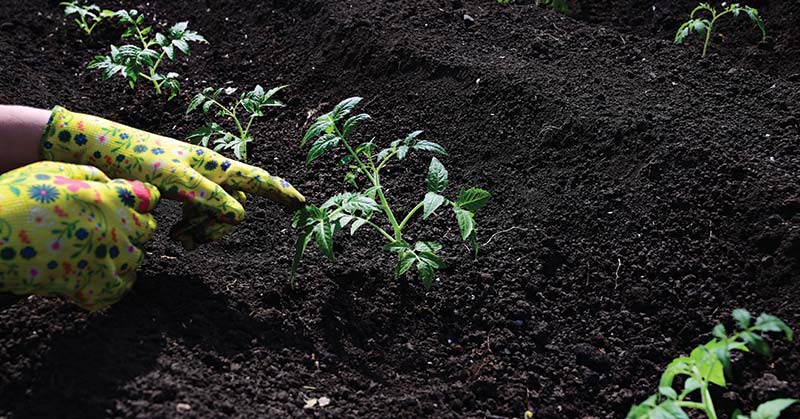Composting is an essential practice for gardeners looking to enrich their soil in an eco-friendly way. Tomato plants, in particular, can greatly benefit from composting, both as a nutrient source and as a part of the compost itself.
In this blog post, we’ll explore how to compost tomato plants effectively.
Understanding Composting
Before diving into composting tomato plants, let’s understand what composting is. Composting is the process of recycling organic matter, such as leaves, vegetable scraps, and garden clippings, into a rich soil amendment known as compost.
This natural process involves the decomposition of organic material by microorganisms, which break down the material into nutrient-rich humus.
Why Compost Tomato Plants?
Tomato plants are nutrient-hungry and benefit significantly from the rich, organic matter found in compost. Composting these plants at the end of the growing season can return nutrients to the soil, reducing waste and maintaining a healthy, sustainable garden ecosystem.
Step-by-Step Guide to Composting Tomato Plants
1. Select the Right Tomato Plants for Composting
- Healthy Plants: Only compost tomato plants that are free from diseases and pests. Infected plants can spread diseases in your compost pile and later to other plants.
- Avoid Seed Bearing Plants: If you don’t want volunteer tomato plants growing where you use your compost, avoid composting tomatoes with mature seeds.
2. Prepare Your Compost Bin or Pile
- Location: Choose a dry, shaded spot near a water source for your compost pile or bin.
- Size: Your compost pile should be at least 3 feet wide and 3 feet high.
3. Chop the Tomato Plants
- Smaller Pieces Decompose Faster: Cut or shred your tomato plants into smaller pieces. This increases the surface area for microbes to work on, speeding up the composting process.
4. Layer Your Compost Pile
- Balance Green and Brown Materials: Tomato plants are considered green material, rich in nitrogen. Balance them with brown materials like dry leaves, straw, or shredded newspaper, which are rich in carbon.
- Maintain Ratio: Aim for a ratio of about 2:1 of brown to green materials.
5. Maintain Your Compost Pile
- Moisture: Keep your compost pile as moist as a wrung-out sponge.
- Aeration: Turn your pile every few weeks to aerate it, which helps speed up the composting process and prevents odor.
6. Monitor the Compost Process
- Temperature: A well-maintained compost pile will heat up in the center, which is a sign of the composting process working effectively.
- Timeframe: The composting process can take anywhere from a few months to a year.
7. Use the Compost
- Maturity: When the compost is dark, crumbly, and has an earthy smell, it is ready to use.
- Application: Spread the compost in your garden beds, around the base of plants, or use it as a part of your potting mix.
Common Mistakes to Avoid
- Composting Diseased Plants: This can spread diseases in your compost and to your garden.
- Not Balancing Green and Brown Materials: This can lead to a smelly, slow-decomposing pile.
- Ignoring the Pile: Not turning the pile or maintaining proper moisture can slow down the composting process.
Conclusion
Composting tomato plants is a fantastic way to recycle your garden waste into a valuable resource for your garden. By following these steps, you can create a rich, organic compost that will nourish your garden and help produce a bountiful harvest in the seasons to come. Remember, successful composting is about balance, care, and patience.
FAQs on How to Compost Tomato Plants
Q: Can I compost tomato plants that have been treated with pesticides?
A: It’s not recommended to compost tomato plants that have been treated with pesticides. These chemicals can remain in the compost and may harm beneficial microbes or the plants you later feed with the compost.
Q: How long does it take for tomato plants to decompose in a compost pile?
A: The decomposition time varies, but typically, it can take anywhere from a few months to a year for tomato plants to fully decompose in a compost pile, depending on factors like size of the pieces, composting conditions, and maintenance.
Q: Should I remove the tomatoes and seeds before composting the plants?
A: Yes, it’s a good idea to remove mature tomatoes and seeds to prevent unwanted tomato plants from sprouting in areas where you use the compost.
Q: Can diseased tomato plants be composted safely?
A: No, it’s not advisable to compost diseased tomato plants as they can spread pathogens to the compost and subsequently to other plants in your garden.
Q: How often should I turn my compost pile containing tomato plants?
A: It’s recommended to turn your compost pile every few weeks to aerate it, which helps accelerate the decomposition process and prevents odor.
Q: What is the ideal ratio of green to brown materials when composting tomato plants?
A: Aim for a ratio of about 2:1 of brown materials (like dry leaves or straw) to green materials (such as tomato plants). This balance helps maintain an effective composting process.
Q: Can I compost tomato plants with their stakes and ties?
A: No, you should remove stakes, ties, and any non-biodegradable materials from tomato plants before composting as these items will not decompose.
Q: How do I know when the compost made from tomato plants is ready to use?
A: The compost is ready when it’s dark, crumbly, and has an earthy smell. It should no longer look like the original materials and should be uniform in texture.
Q: Can composting tomato plants attract pests to my compost bin?
A: If composted properly, tomato plants shouldn’t attract pests. However, make sure to bury the green materials under brown materials to minimize attracting pests like fruit flies.
Q: Should I add water to my compost pile with tomato plants?
A: Yes, maintaining moisture is important. Your compost pile should be as moist as a wrung-out sponge to support the composting process effectively.




